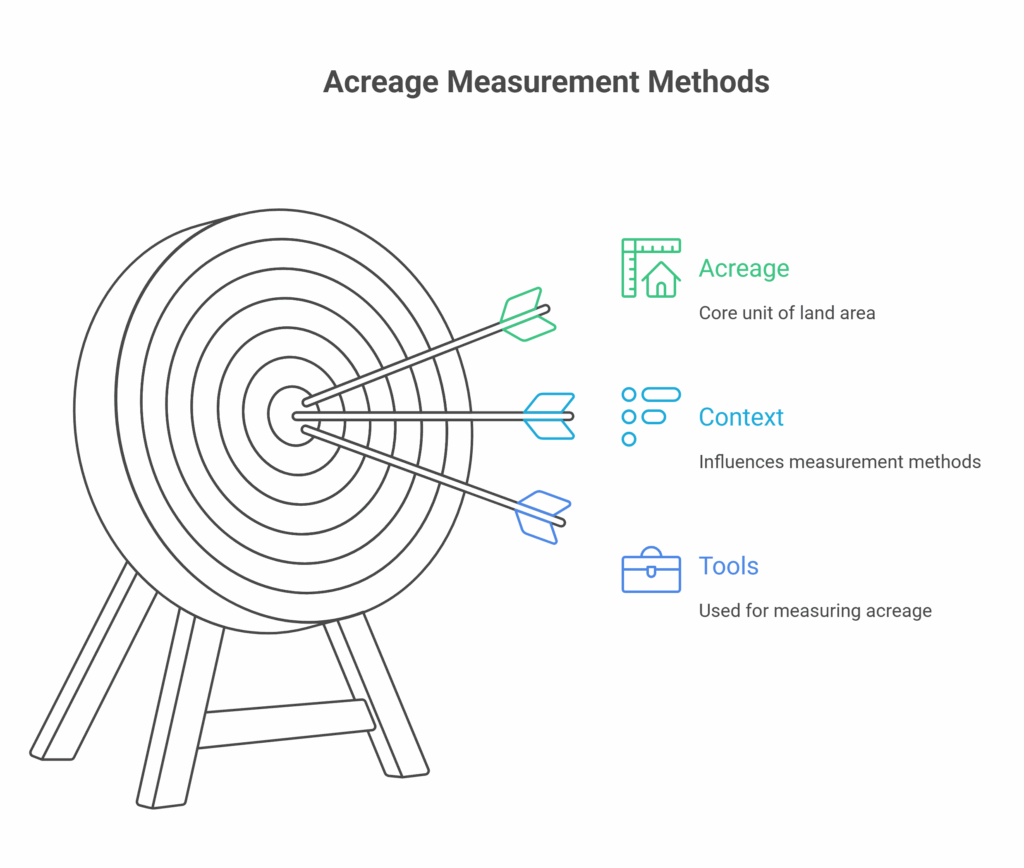Quick Answer: How Is Acreage Measured?
How Is Acreage Measured? Acreage is calculated by determining the total square footage of a piece of land and then converting it into acres. Since one acre equals 43,560 square feet, surveyors or property owners typically multiply the land’s length by its width to get the total square footage, and then divide that number by 43,560. For irregularly shaped lots, professionals often break the land into smaller sections, calculate each area, and then add them together before converting to acres. Today, digital tools, mapping apps, and GPS technology make the process much easier and more precise.
So, when someone asks, “How Is Acreage Measured?”—the short answer is: by using math, measurement tools, and sometimes a little modern tech help.
Now let’s dive deeper.

First Things First: What Exactly Is an Acre?
Let’s define the basics.
An acre is the standard unit of measurement for land in the U.S. and several other countries. One acre equals exactly 43,560 square feet.
To help you visualize:
- That’s about 90% of a football field (no touchdowns needed).
- Roughly 16 tennis courts.
- Or 9 NBA basketball courts if you’re more into hoops than horticulture.
Historically, an acre was the amount of land a pair of oxen could plow in one day. While we don’t measure land by bovine efficiency anymore, the standardized size stuck around—and thank goodness for that.
The Basic Math: Square Feet to Acres
So, how is acreage measured using good old-fashioned math?
Here’s the simple formula:
Length × Width (in feet) = Square Feet
Square Feet ÷ 43,560 = Acres
Let’s say your land measures 300 feet by 400 feet:
- 300 × 400 = 120,000 sq. ft.
- 120,000 ÷ 43,560 = 2.75 acres
Easy, right? Just don’t forget your calculator—or coffee.
But What If the Land Isn’t a Perfect Rectangle?
Most plots aren’t. Nature isn’t a fan of straight lines.
If your land is irregularly shaped, you’ll need to:
- Break it into smaller shapes (rectangles, triangles, etc.).
- Calculate each smaller area individually.
- Add them up.
- Divide the total square footage by 43,560.
Its geometry meets jigsaw puzzle. Not your thing? Hang tight—we’ll talk about tech and pros who can help.
5 Ways to Measure Acreage (From DIY to High-Tech)
1. Manual Measuring
Grab a long measuring tape or a measuring wheel. This works well for small, flat parcels.
- Walk the length and width.
- Multiply and divide as shown earlier.
- Bonus tip: Don’t trip over your own tape. (Yes, it happens.)
2. Google Maps or GPS Apps
Got a smartphone? You’ve got a tool.
- Use Google Earth or satellite tools to outline your lot.
- Some GPS-based apps will even do the area calculation for you.
Ideal for rough estimates, and no need for bug spray.
3. Professional Survey Equipment
If accuracy matters, bring in the big guns.
- Surveyors use GPS receivers, theodolites, and CAD software.
- Especially useful for large, uneven, or legal-boundary-sensitive plots.
It costs more, but it’s the difference between “probably 2 acres” and “2.13 acres with documentation.”
4. Property Documents
Your deed, plat map, or subdivision layout might already include the acreage.
- Look at the legal description.
- Check the boundary dimensions and scale.
If you inherited the property or bought it long ago, it’s worth digging through the paperwork—or asking the county office.
5. Acreage Calculators
Just plug in your measurements and let the online tool do the rest.
- Works well with known lengths and widths.
- Great for quick checks, especially when comparing listings or verifying land size.
(Warning: Don’t rely on these alone for legal transactions—but they’re handy for “Is this really one acre or just wishful thinking?” moments.)
Other Units and Quick Conversion Tips
If you’re dealing internationally or with surveyors, here’s how 1 acre translates:
- 4,840 square yards
- 4,046.86 square meters
- 0.4047 hectares
- 0.00156 square miles
Let’s be honest—no one casually drops “hectares” at a BBQ, but it helps to know just in case.
When to Call a surveyor (a.k.a. the Acre Whisperers)?
You might want to hire a professional when:
- There’s a land dispute with neighbors (yes, fence lines matter).
- You’re selling or subdividing land.
- The shape or topography is highly irregular.
- You need official documentation for government records or construction.
A licensed land surveyor ensures no surprises—and no awkward conversations with the buyer about “missing feet.”
Common Mistakes to Avoid
- Don’t assume flat land equals flat math—slopes affect usable area.
- Eyeballing is not a reliable measurement technique (even if your cousin insists).
- Always use consistent units (don’t mix feet with meters, unless confusion is your goal).
Final Words
Calculating acreage isn’t rocket science, but a bit of learning about land mathematics, land survey mapping, and a lot of patience sometimes are needed. Locally or on satellite screens, you must know how acreage gets measured to be in control.
It helps you price land correctly, plan for development, and avoid legal surprises. Even if you’re not a surveyor, understanding your property size is one of the smartest things you can do as a homeowner or land investor.
At Move On House Buyers, we’ve worked with property owners across Texas who weren’t even sure how big their land was—but they knew they needed to sell fast. Whether you’ve got a tenth of an acre or ten acres, we’re here to help you sell my house fast Texas without the headaches of repairs, listings, or agent commissions. We’ll make you a fair cash offer—acreage questions welcome!
Call us anytime at 713-561-5162 or connect with us on our website and we’ll lay out all of your options for your specific situation.
